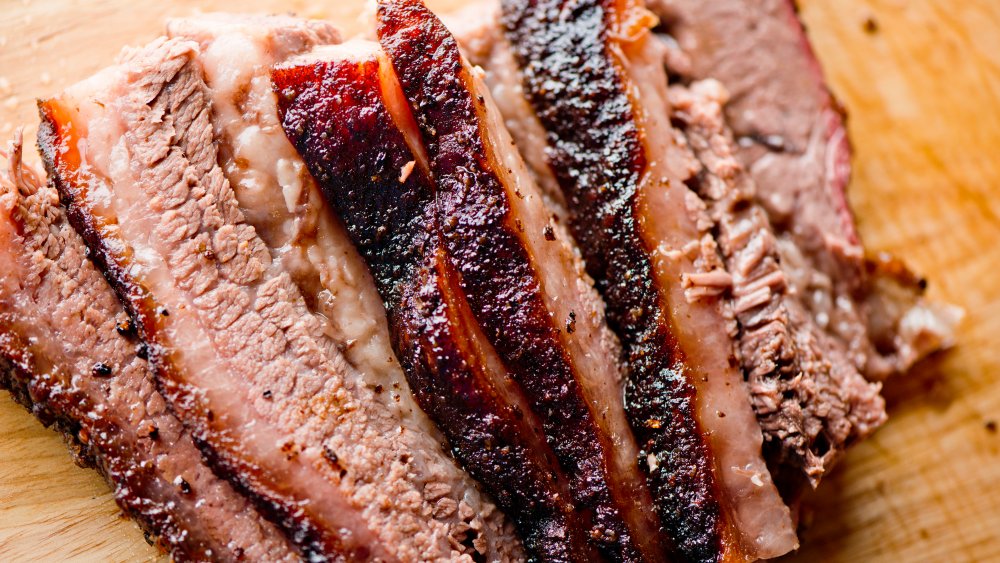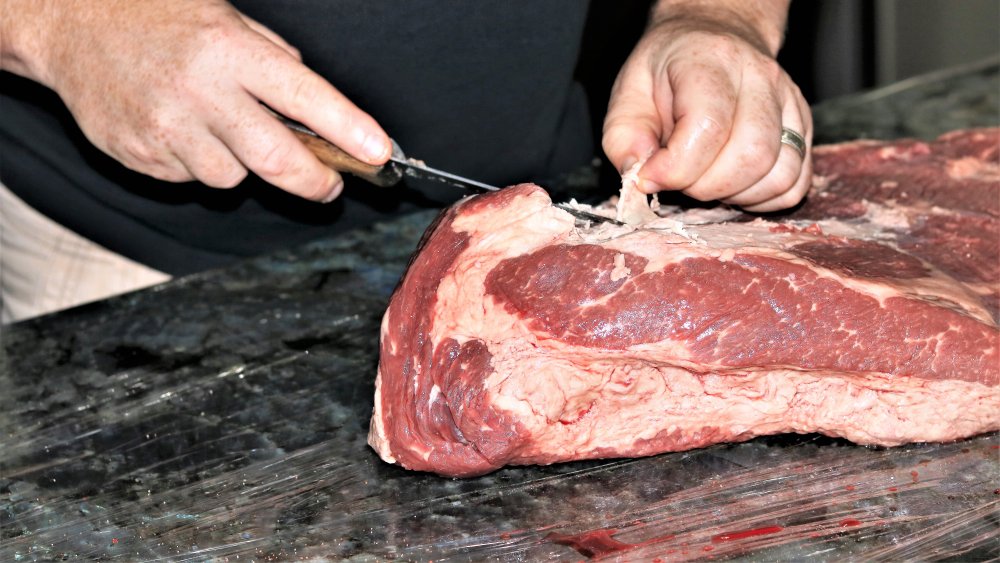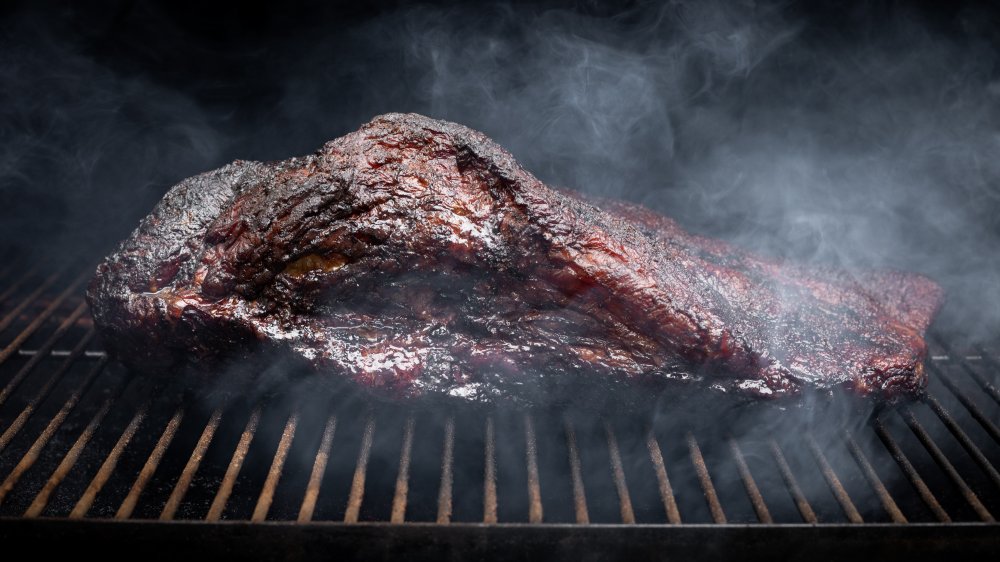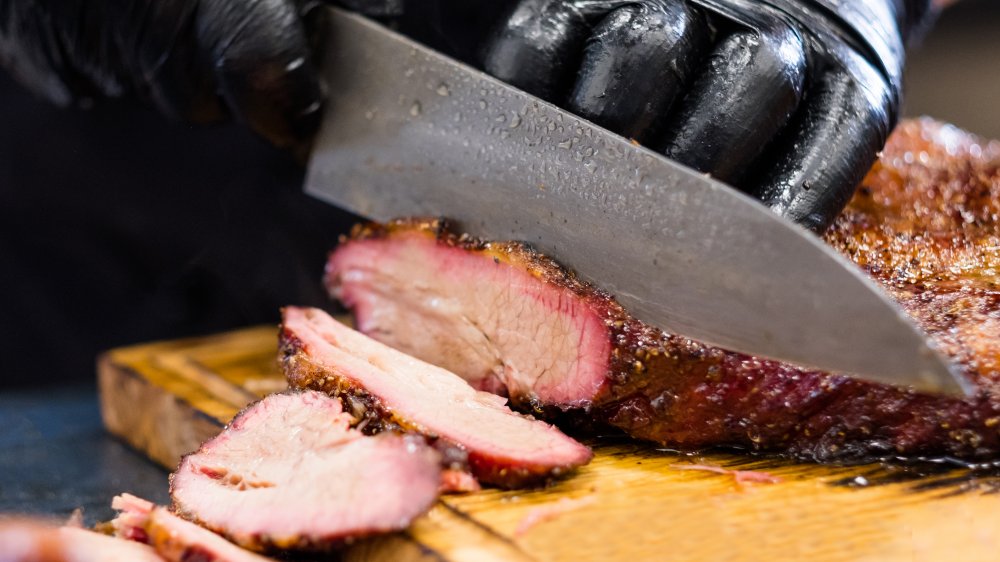You've Been Cooking Brisket Wrong This Whole Time
Brisket is a beef cut with many personalities. It's the centerpiece of any Jewish grandmother's holiday table, and it's also a must for any self-respecting down-home Texas-style barbecue. In it's corned beef form, brisket is also everybody's St. Patrick's Day go-to, far more flavorful than the boiled cabbage it so often accompanies. Brisket often gets a bad rap among home cooks, however, since it can be notoriously difficult to cook, and if not cooked correctly, can be tougher than Chuck Norris' drill instructor.
Believe it or not, you can actually learn to master brisket in your own kitchen without the aide of an on-call bubbie or pit master. Yes, it will require a little meal prep work, starting with buying the right cut and ending with how (and when) you serve it. The following tips and tricks should give you the inside knowledge that will allow you to make your brisket relatively risk-free.
Don't choose the wrong cut
There are two different cuts of brisket — first cut, aka the flat cut, and second cut, aka the point cut. Food blogger Tori Avey points out that first cut is usually easier to find at your grocery store butcher. She says second cut also works well; it has a lot more fat running through the meat, although this fat may not be visible on the surface with marbling as it would in a steak.
The fat does tend to make the point cut tastier — as Brent Young, co-owner and butcher at The Meat Hook in NYC, tells Food & Wine: "My personal preference is the point cut because it has more fat and its texture is more like a chuck roast." Paul Whitman, one of the owners of the Fischer Bros & Leslie butcher shop on the Upper West side, is even more adamant, telling The Nosher to forget the first cut since the second cut has a much better flavor.
Don't cook it too quickly
If you don't want your brisket coming out tough, it's going to take some time. As Sandy Leibowits of The Kosher Tomato advises (via The Nosher): "Cook it low and slow in a liquid that covers the meat about halfway. A fork should pierce and slide out easily when done properly."
As far as the "low" part goes, this refers to temperature, of course. Cooking brisket at too high a heat may also toughen it up. Cookbook author Ronnie Fein advises 250 degrees as the perfect brisket-cooking temperature, and warns never to let the temp get above 300 degrees. Steve Raichlen's Barbecue Bible also swears by "low and slow" for brisket, saying "It takes a low temperature (215 to 225 degrees) and long cooking time (15 to 20 hours) to melt the collagen, fat, and other tough connective tissue in the brisket." While they are talking about cooking a whole brisket (both flat and point), that time estimate may not be far off what it takes to cook a smaller cut — Tori Avey says it may take 14 hours or more to get your brisket really tender.
Be careful how you slice it
Once you've cooked your brisket, you'll need to have sufficient patience to let it cool down thoroughly before you even think about slicing it. The Nosher explains that when brisket is hot, the fibers of the meat are still soft, so if you try to carve it at this time, all of the slices will come out raggedy and uneven.
What's more, you'll need to pay particular attention to just how you slice your brisket once it has cooled down enough to do so. Food writer Leah Koenig insists (via The Nosher) that the only way to slice a brisket is against the grain, never along it. Any brisket that has been improperly sliced along the grain, no matter how carefully it's been cooked, will still be fork-tough.
Don't forget to plan ahead
Not only does cooking the brisket itself take a long, long time, but if you really want to do it right, The Nosher suggests you really ought to be cooking your brisket a day or two before you plan to serve it. They explain that like many soups, stews, and other saucy dishes, letting brisket sit overnight (or longer) allows its flavors to "marry". Tori Avey is also a fan of making brisket ahead of time and letting it honeymoon in the refrigerator overnight, where its newlywed flavors can deepen as they get better acquainted.
If you do make your brisket ahead of time, let it cool for about 20 minutes or so before putting it in the refrigerator in a glass or ceramic baking dish along with its cooking juices. Do not slice it yet! Cover the whole brisket with plastic wrap — don't use foil, as this may react with an acidic sauce. When you're ready to serve the brisket, skim off any solidified fat from the surface of the liquid, then remove the brisket from the sauce and slice it while it's still cold. Return the slices to the baking dish, spoon the sauce over top of them, then cover the dish with a layer of parchment and the one of foil. Heat at 350 degrees for about an hour or so, adding liquid if necessary so the brisket won't dry out.




